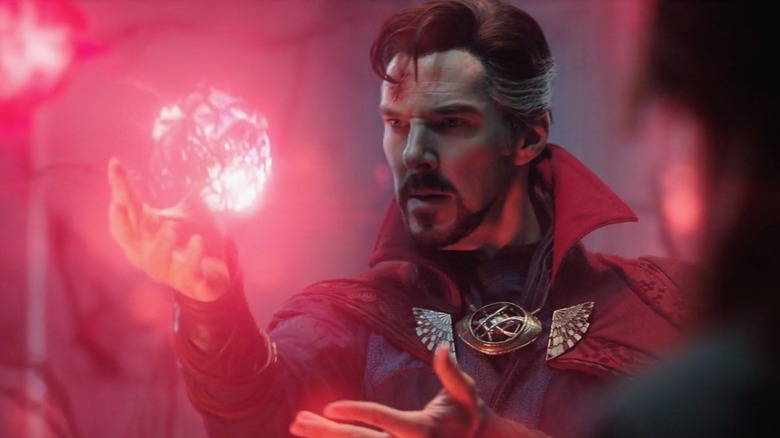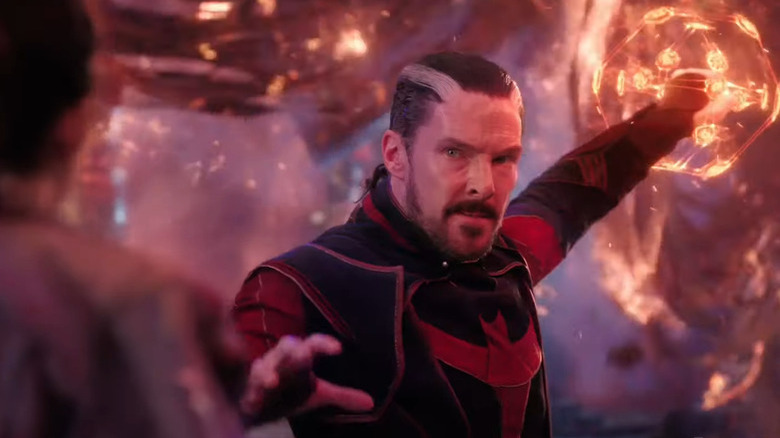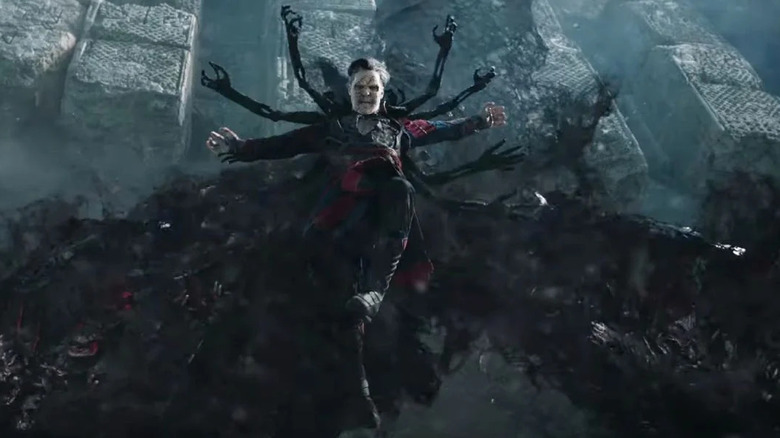The Magic In Doctor Strange 2 Is Ridiculous And That's Why It Rules
Warning: This article contains major spoilers for "Doctor Strange in the Multiverse of Madness"
Despite some very cool and trippy visuals with the Astral Plane and Mirror Dimension, magic in the first "Doctor Strange" was kind of bland, mostly just involving Dr. Stephen Strange using a magic whip to hit people in the face and everyone conjuring tiny shields with magic.
All that changes with "Doctor Strange in the Multiverse of Madness," a movie filled with moments of gnarly horror, but also plenty of magical silliness that fully embraces what it means to be in a world where magic is real. This also culminates in arguably one of the most ridiculously cool sequences in the entire MCU.
Stephen Strange as Mickey Mouse
The true highlight of the movie, one that already includes the introduction of America Chavez, The Illuminati, and Patrick Stewart's triumphant return as Professor Xavier — the one from the excellent 1997 cartoon, no less — is actually about two Doctors Strange fighting.
In the scene, an evil Strange (but not the one from Marvel's "What If...?") decides to kill Earth-616 Strange, steal his Christine, and go to his universe. Before he can enact his terrible plan, however, our Stephen uses magic to shoot a literal music note like a knife, one that even emits music when it hits its target. Immediately, the evil Strange realizes what a cool concept this is, and the two start shooting musical notes, with good Stephen playing Beethoven's "5th Symphony," and evil Stephen playing the appropriate "Toccata and Fugue in D minor, BWV 565" by Bach — a piece that is usually used to signify an evil or scary character.
The sequence plays out almost like a live-action adaptation of "The Sorcerer's Apprentice" short in "Fantasia." It works here because we already saw Strange use magic in silly ways, and also saw how the multiverse breaks the rules of logic, allowing for the rule of cool to reign supreme. Indeed, this is a silly, funny break from the horrors of the rest of the film, just like the Bolero sequence in "Legion," which balanced horror imagery and complex psychological subjects with incredibly silly sequences.
Sam Raimi understands that in order to make a movie about magic feel, well, magical, you need to show the possibilities that come with it. "Doctor Strange in the Multiverse of Madness" never shows one type of magic to be dominant or one to be the right one. At the beginning of the film, we see Strange conjure a magical creature to fight Gargantos like he was playing "Pokémon," and later on he conjures a hydra to distract Wanda.
Stephen Strange as Chernobog
And that is just the good kind of magic. This sequel also shows that dark magic is metal as hell, with some of the best scenes in the movie involving Wanda acting like Sadako from "The Ring," possessing another Wanda, and killing the entire Illuminati like she was Vader mowing down Rebels in "Rogue One."
Then there's zombie Doctor Strange. Admittedly, I was pretty disappointed when the two Stephen Strange variants we see in the film — straight up two of the variants we clearly see in "What If...?" — end up having nothing to do with "What If...?" And yet, Earth-616 Strange possesses the dead body of one of his variants, complete with "Evil Dead"-esque practical makeup that's both scary and funny at the same time. And as if that wasn't enough of a flex, he then proceeds to use magic to tie up the Souls of the Damned to make a new Cloak of Levitation that flies Stephen as if he was Chernobog from "Fantasia." He is now a true spawn of hell, with a cape made up of little demons that eat up magic attacks from Wanda and everything.
This is akin to "Star Wars" balancing Obi-Wan's mind-tricks and force pushes with Darth Vader's force choke, and later with the Emperor's force lightning, to showcase how rad the dark side is. "Doctor Strange" finally understands that we need more than "Inception" visuals to sell the idea that magic in this universe is cool and difficult to master. After all, if this was Strange in the five years between the first "Doctor Strange" and this one (that is including the five he was Blipped), then imagine what he can do with another five years of training.
As the MCU introduces more and more magic users and different types of magic — especially in light of that mid-credits scene — the biggest contribution "Doctor Strange in the Multiverse of Madness" does for the MCU is to show that magic is more than orange whips and red balls of light. Magic can be scary, it can be metal, and it can be quite silly. Whenever the Avengers assemble again to face off against a world-ending threat, let's just hope they remember to use their greatest weapon: Beethoven's 5th.
"Doctor Strange in the Multiverse of Madness" is now out in theaters.


